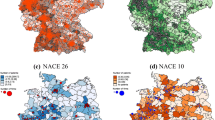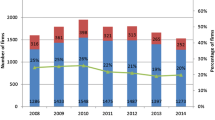Abstract
Using a sample of Italian manufacturing firms over the period 2004–2006, a knowledge production function is estimated to investigate the role of knowledge spillovers in the innovative performance of Italian manufacturing firms. Sales of innovative products are used as measure of firm innovative performance. The role of innovative spatial externalities are analysed through the use of spatial econometric techniques. Overall, the results show evidence of a positive role of geographical proximity in innovation.
Similar content being viewed by others
Notes
At firm level, Carboni (2013a, b) used spatial econometric techniques to investigate related issues: the importance of geographical and sectoral proximity in promoting R&D investment and R&D collaboration among Italian manufacturing firms; Baltagi et al. (2016 and 2015) investigated the role of spatial spillovers in the productivity of Chinese chemical firms over 2004–2006 and of China’s electric and electronic manufacturing firms over 2004–2007, respectively; Lamieri and Sangalli (2013) allowed for spatial dependence in both dependent variable and error terms across firms in the evaluation of the impact of patents on the total factor productivity (TFP) of Italian manufacturing firms in 2010; Cardamone (2017) used a sample of Italian manufacturing firms over the period 2004–2006 to analyse the role of R&D in firm productivity by employing a spatial autoregressive model.
The survey is compiled on the basis of information collected by means of a questionnaire sent to a sample of Italian manufacturing firms and is complemented with balance sheet data. The survey includes all firms with a minimum of 500 employees and a sample of firms with between 11 and 500 employees selected on a three-dimension stratification: geographical area, Pavitt sector and firm size. Although the survey covers the 2004–2006 period, some parts of the questionnaire refer to 2006 only.
Sales are deflated through the production price index which is available for each sector according to the Ateco (Italian edition of Nace) classification of economic activities. For the tangible fixed assets, values have been deflated by using the average production price indices of the following sectors: machines and mechanical appliances, electrical machines and electrical equipment, electronics and optics and means of transport. R&D investments are deflated by considering the producer price index for industrial products. The source of the price indices is Istat.
The status of ‘exporting’ is assigned on the basis of the positive answer on the question if the firm exported in 2006 in the Xth wave of the UniCredit–Capitalia survey.
Moreover, a spatial error model (SEM) could be used in order to control for the fact that a random shock to a firm in a specific location l, i.e. a shock in the error u of a firm at a location l, could be transmitted to other firms located nearby: \(\mathbf{y} = \mathbf{X }{\varvec{\upbeta }} + \mathbf{u}, \mathbf{u}= \uplambda \mathbf{Wu}+ {\varvec{\upvarepsilon }}\).
http://clisun.casaccia.enea.it/Pagine/Comuni.htm (last accessed: July 2015). Data regarding the town “Due Carrare”, which were not available in the ENEA dataset, are taken from http://www.tuttitalia.it/veneto/87-due-carrare/ (last accessed: July 2015).
In a min-max normalized matrix, each element is divided by the minimum of the largest row sum and column sum of the matrix. This normalization avoids some issues which arise when row-sum standardization is used (Kelejian and Prucha 2010).
In order to investigate the effect of R&D spillovers on innovative output, also the spatial lag of R&D was introduced in the model. In other words, \({{\varvec{W}}}\cdot {{\varvec{RDinv}}}\) is included in equation (1), where W is the spatial weighting matrix and RDinv is the vector of the R&D indicator. However, results, available upon request, show that geographical R&D spillovers have no significant impact on innovation of Italian manufacturing firms.
Likelihood ratio (LR) tests are employed to compare the spatial Durbin model (SDM) with the spatial autoregressive model and the spatial error model. LR test results show that we cannot reject the hypothesis that the SAR and the SEM describe the data better than the SDM: statistical test value is equal to 6.53 (p-value = 0.686) in the first case and 8.36 (p-value = 0.498) in the second case. Results on the SEM model are reported for comparison in Table 7 of the appendix. The lambda coefficient is not significant. Hence, there is no evidence in favour of spatial dependence in unobservable factors.
Both the maximum likelihood (ML) and the two stage least squares (2SLS) estimators are used to estimate the model. Results obtained considering the two approaches do not substantially vary.
References
Acs, J.Z., Audretsch, D.B.: Innovation, market structure, and firm size. Rev. Econ. Stat. 69(4), 567–574 (1987)
Acs, J.Z., Anselin, L., Varga, A.: Patents and innovation counts as measure of regional production of new knowledge. Res. Policy 31, 1069–1085 (2002)
Aldieri, L., Cincera, M.: Geographic and technological R&D spillovers within the triad: micro evidence from US patents. J. Technol. Transf. 34, 196–211 (2009)
Anselin, L., Le Gallo, J.: Interpolation of air quality measures in hedonic house price models: spatial aspects. Spat. Econ. Anal. 1(1), 31–52 (2006)
Anselin, L., Varga, A., Acs, Z.: Local geographic spillovers between university research and high technology innovations. J. Urban Econ. 42, 422–448 (1997)
Antonelli, C.: Collective knowledge communication and innovation: the evidence of technological districts. Reg. Stud. 34, 535–547 (2000)
Antonelli, C.: Endogenous innovation: the creative response. Econ. Innov. New Technol. 26(8), 689–718 (2017)
Arrow, K.: The economic implications of learning by doing. Rev. Econ. Stud. 29, 155–172 (1962)
Audretsch, D.B., Feldman, M.P.: Spillovers and the geography of innovation and production. Am. Econ. Rev. 86, 630–640 (1996)
Audretsch, D.B., Feldman, M.P.: Knowledge spillovers and the geography of innovation. Handb. Reg. Urban Econ. 4, 2713–2739 (2004)
Autant-Bernard, C.: Spatial econometrics of innovation: recent contributions and research perspectives. Spat. Econ. Anal. 7, 403–419 (2012)
Autant-Bernard, C., LeSage, J.P.: Quantifying knowledge spillovers using spatial econometric models. J. Reg. Sci. 51, 471–496 (2011)
Baltagi, B.H., Egger, P.H., Kesina, M.: Sources of productivity spillovers: panel data evidence from China. J. Prod. Anal. 43(3), 389–402 (2015)
Baltagi, B.H., Egger, P.H., Kesina, M.: Firm-level Productivity Spillovers in China’s Chemical Industry: A Spatial Hausman-Taylor Approach. J. Appl. Econom. 31(1), 214–248 (2016)
Belderbos, R., Carree, M., Lokshin, B.: Cooperative R&D and firm performance. Res. Policy 33, 1477–1492 (2004)
Beugelsdijk, S.: The regional environment and a firm’s innovative performance: a plea for a multilevel interactionist approach. Econ. Geogr. 83(2), 181–199 (2007)
Bivand, R., Piras, G.: Comparing implementations of estimation methods for spatial econometrics. J. Stat. Softw. 63(18), 1–36 (2015)
Bivand, R.S., Hauke, J., Kossowski, T.: Computing the Jacobian in Gaussian spatial autoregressive models: an illustrated comparison of available methods. Geogr. Anal. 45(2), 150–179 (2013)
Boschma, R.A.: Proximity and innovation: a critical assessment. Reg. Stud. 39, 61–74 (2005)
Bottazzi, L., Peri, G.: Innovation and spillovers in regions: evidence from European patent data. Eur. Econ. Rev. 47, 687–710 (2003)
Bugamelli, M., Cannari, L., Lotti F., Magri S.: Il gap innovativo del sistema produttivo italiano: radici e possibili rimedi. Questioni di Economia e Finanza (Occasional papers), n. 121. Bank of Italy (2012)
Carboni, O.A.: A spatial analysis of R&D: the role of industry proximity. Econ. Innov. New Technol. 22(8), 820–839 (2013a)
Carboni, O.A.: Spatial and industry proximity in collaborative research: evidence from Italian manufacturing firms. J. Technol. Transf. 38(6), 896–910 (2013b)
Cardamone, P.: A spatial analysis of the R&D-productivity nexus at firm level. Growth Change 48(3), 313–335 (2017)
Cohen, W.M., Levinthal, D.A.: Absorptive capacity: a new perspective on learning and innovation. Adm. Sci. Q. 35(1), 128–152 (1990)
Conte, A.: Mapping innovative activity using microdata. Appl. Econ. Lett. 16(18), 1795–1799 (2009)
Crépon, B., Duguet, E., Mairesse, J.: Research, innovation and productivity: an econometric analysis at the firm level. Econ. Innov. New Technol. 7, 115–158 (1998)
Criscuolo, C., Squicciarini, M., Lehtoranta O.: R&D, innovation and productivity, and the CIS: sampling, specification and comparability issues. MPRA Paper No. 39261 (2010)
Doloreux, D.: What we should know about regional systems of innovation. Technol. Soc. 24(3), 243–263 (2002)
Drukker, D.M., Peng, H., Prucha, I.R., Raciborski, R.: Creating and managing spatial-weighting matrices with the spmat command. Stata J. 13(2), 242–286 (2013)
Fischer, M.M., Varga, A.: Spatial knowledge spillovers and university research: evidence from Austria. Ann. Reg. Sci. 37(2), 303–322 (2003)
Fritsch, M., Franke, G.: Innovation, regional knowledge spillovers and R&D co-operation. Res. Policy 33, 245–255 (2004)
Griliches, Z.: Issues in assessing the contribution of research and development to productivity growth. Bell J. Econ. 10, 92–116 (1979)
Heckman, J.: Sample selection bias as a specification error. Econometrica 47(1), 153–61 (1979)
Jaffe, A.B.: Real effects of academic research. Am. Econ. Rev. 79, 957–970 (1989)
Jaffe, A.B., Trajtenberg, M., Henderson, R.: Geographic localization of knowledge spillovers as evidenced by patent citations. Q. J. Econ. 108(3), 577–98 (1993)
Kelejian, H.H., Prucha, I.R.: Specification and estimation of spatial autoregressive models with autoregressive and heteroskedastic disturbances. J. Econ. 157, 53–67 (2010)
Koo, J.: Technology spillovers, agglomeration, and regional economic development. J. Plan. Lit. 20, 99–115 (2005)
Lamieri, M., Sangalli, I.: Produttività e innovazione: un approccio spaziale. Econ. Polit. Ind. 40(2), 67–89 (2013)
LeSage, J., Pace, R.K.: Introduction to Spatial Econometrics. Chapman & Hall/CRC, Boca Raton (2009)
Lööf, H., Broström, A.: Does knowledge diffusion between university and industry increase innovativeness? J. Technol. Transf. 33, 73–90 (2008)
Love, J.H., Roper, S., Vahter, P.: Learning from openness: the dynamics of breadth in external innovation linkages. Strateg. Manag. J. 35, 1703–1716 (2014)
Mairesse, J., Mohnen, P.: To be or not to be innovative: an exercise in measurement. National Bureau of Economic Research (NBER) Working Paper No. 8644 (2001)
Mohnen, P., Mairesse, J., Dagenais, M.: Innovativity: a comparison across seven European countries. Econ. Innov. New Technol. 15(4–5), 391–413 (2006)
Monjon, S., Waelbroeck, P.: Assessing spillovers from universities to firms: evidence from French firm-level data. Int. J. Ind. Organ. 21, 1255–1270 (2003)
Moreno, R., Paci, R., Usai, S.: Spatial spillovers and innovation activity in European regions. Environ. Plann. 37, 1793–1812 (2005)
Netval: Brevetti e imprese per il sistema Paese: il contributo dell’università. Sesto rapporto Netval sulla valorizzazione della ricerca nelle università italiane. (http://netval.it/static/media/uploads/files/20090507_Rapporto_Netval_2008.pdf) (2008)
Nieto, M.J., Santamaria, L.: The importance of diverse collaborative networks for the novelty of product innovation. Technovation 27, 367–377 (2007)
Orlando M.: On the importance of geographic and technological proximity for R&D spillovers: an empirical investigation. Federal Reserve Bank of Kansas City, RWP 00-02 (2000)
Paci, R., Marrocu, E., Usai, S.: The complementary effects of proximity dimensions on knowledge spillovers. Spat. Econ. Anal. 9(1), 9–30 (2014)
Pakes, A., Griliches, Z.: Patents and R&D at the firm level: a first look. In: Griliches, Z. (ed.) R&D, Patents and Productivity, pp. 55–72. University Press, Chicago (1984)
Pavitt, K.: Sectoral patterns of technical change: towards a taxonomy and a theory. Res. Policy 13, 343–373 (1984)
Piccaluga, A., Balderi, C.: Consistenza ed evoluzione delle imprese Spin-off della ricerca pubblica in Italia, IN-SAT Lab, Scuola Superiore di Sant’Anna, Pisa (2006)
Pietrabissa, R., Conti, G.: Strategia per un rapporto responsabile fra ricerca pubblica e industria. l’Industria XXVI(3), 419–444 (2005)
Piras G.: sphet: Spatial models with heteroskedastic innovations in R. J. Stat. Softw. 35(1), 1–21. URL http://www.jstatsoft.org/v35/i01/ (2010)
Robin, S., Schubert, T.: Cooperation with public research institutions and success in innovation: evidence from France and Germany. Res. Policy 42, 149–166 (2013)
Romer, P.: Increasing returns and long-run growth. J. Polit. Econ. 94, 1002–1037 (1986)
Roper, S., Vahter, P., Love, J.H.: Externalities of openness in innovation. Res. Policy 42(9), 1544–1554 (2013)
Schumpeter, J.A.: Capitalism, Socialism and Democracy. Harper and Brothers, New York (1942)
UniCredit-Capitalia (2008) Decima indagine sulle imprese manifatturiere italiane. Rapporto Corporate, n.1
Author information
Authors and Affiliations
Corresponding author
Rights and permissions
About this article
Cite this article
Cardamone, P. Firm innovation and spillovers in Italy: Does geographical proximity matter?. Lett Spat Resour Sci 11, 1–16 (2018). https://doi.org/10.1007/s12076-017-0193-y
Received:
Accepted:
Published:
Issue Date:
DOI: https://doi.org/10.1007/s12076-017-0193-y




